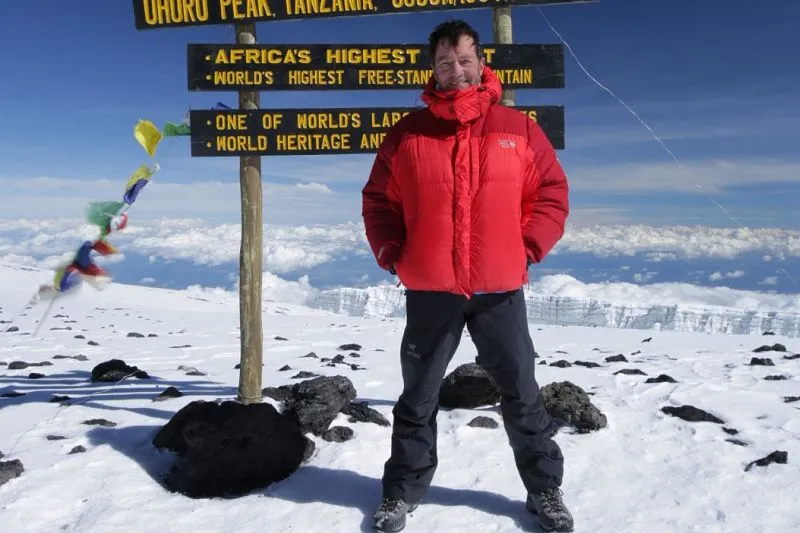Eddie Frank has climbed Mount Kilimanjaro on painful knees 53 times. Now that he has two good new knees, he is able to guide and climb almost as well as he did 43 years ago, on his first expedition.
Partial knee replacements have given Eddie a new lease on trekking life and he encourages those contemplating either a partial or total knee replacement to go for it. A successful surgery can give you a chance to continue your active lifestyle and your pursuit of higher peaks.
“At 66, I couldn’t use my knees. The cartilage was totally gone and they were bone on bone. Three months after my second knee replacement I was horseback riding and trekking ten miles a day in Mongolia without pain. The secret to maintaining your active life is to do your rehab religiously after the surgery, and keep moving,” Eddie said. “I plan to run many more expeditions.”
Worn out knee and psyche
For many globetrotting trekkers age has caught up to their bodies and their minds. Knees are the largest joints in our bodies and bear the greatest loads especially on downhill sections of steep mountains such as Kilimanjaro. Once cartilage totally wears out, hiking can become too painful for many of us. Without knee cartilage you have two options, have a medical procedure such as a knee replacement or read about it at home.
By hanging up your Vibrams you lose a big part of your soul and psyche. Exploring the natural world is a big part of who we are, and to stay in the life fulfilling game, many don’t consider a knee replacement. The reasons are many—fear of medical procedures is a big one—but it’s also about ego. A knee replacement makes many think they have become “old” and feel ashamed about joining a hiking group with trekkers in better condition.
But people in their 50’s have knee replacements too; this is not a sign of old age and there should be no shame. “I’ve had people climb Kilimanjaro with us who have had total knee replacements, and you never would have known,” Eddie said.
The shame factor is a big mental mistake because a successful knee replacement can take 20 or more years off your age and jettison your psyche. Getting new knees and getting back on the trail can prolong your life. Think of it as buying a new set of tires. As long as the engine is good, you’ve got another 50,000 miles to put on the clock. An increasing number of active people are having artificial knee surgery. For ardent hikers new knees gets them to that chapel above tree line, Uhuru Peak at 19,341 feet.
Makoplasty to the rescue
As medical technology has improved more hikers have turned to knee replacement surgery. In 2010, there were 650,000 procedures and today it’s approaching 700,000 in the U.S. Right now in the U.S., the total population above the age of 50 that has a total knee replacement is 4.7%. The biggest advance is called makoplasty and involves a robotic arm that is guided by 3D modeling of your knee taken by a scan. Your surgeon guides the robotic arm and there is a check system that spares healthy bone and surrounding tissue while resurfacing the parts that need it. Metal alloy plates, coated with wear-resistant plastic act as cartilage like to prevent bone on bone grinding.
There is a big difference between partial and total knee replacements. In a partial replacement just one of your three knee compartments are replaced. A total replacement includes the lateral and front parts of the knee and is more invasive requiring a longer rehab.
Eddie did his deep dive homework before choosing makoplasty. He had spent many years and seven knee operations, living on anti-inflammatories, and considered stem cell treatment, but without cartilage he was down to his last resort, knee replacement. Eddie had seven knee operations, the first in 1972 well before arthroscopic surgery and valiantly gimped for decades until he had two partial knee replacements in separate operations in 2018. He choose makoplasty and a partial knee replacement that left his healthy ACL intact, which meant a shorter rehab period. His surgeon was in Los Angeles and Eddie traveled for the best and most modern medical treatment available.
Ice & Exercise
Once you’ve made the decision to have replacement surgery Eddie says you must approach the post-op rehab with as much determination as when you conquered Kilimanjaro for the first time. It’s a regimen requiring painstaking care about your diet, exercise routine as well as maintaining mental toughness.
It may be trite, but without pain there is no gain and it will take you three to six months of hard work to get your new knee back on the trail following surgery. The first week is hell as the post-surgery pain kicks in and ice becomes your best friend. Eddie ices 20 minutes every two to three hours during his rehab and still uses it frequently. Movement is key early on because you don’t want your muscles to atrophy and you want to avoid scar-tissue buildup. “It’s important to strengthen all the muscles that support your new knee and that includes your core and your gluts, “Eddie said. Soon after surgery Eddie was on a stationary bike at the gym for an hour a day and that became his go to exercise to strengthen the new knee. Others spend time in a pool or a treadmill to strengthen their knee. Eddie’s left knee has always been weaker and required more post-op work with the physio who tweaked it to where he is now back to 95 percent with it. Still, Eddie now considers his new knees the strongest parts of his body.
The long road back to mobility
You will find there is an increasing army who have had knee replacements and are now back on the circuit climbing the highest and most spectacular peaks on the planet. Medical stats indicate that 85 to 90 percent of the surgeries are successful for up to 15 years depending on your level of activity. Patients range from 50 to 80 years old with the average at 70. Women comprise 60 percent of knee replacement patients.
Replacing a knee is not an easy decision. It’s personal and requires a lot of homework before the surgery and a lot of hard work on the long road back to full mountain mobility. Talk to surgeons, ask a lot of questions, do your research. Talk to people you hike with and see how their replacements have gone if they had one. There are blog posts from mountain hikers who describe their experiences after surgery and describe what it’s like to be back on major mountains such as Kilimanjaro.
Life is short and body parts wear out, but knees are like tires. They lose tread, blow out, but thanks to medical advances can be replaced. You’re active outdoor life can be prolonged with a new knee.
You can continue your adventures with your new set of tires.
Ready to Explore?
Tusker Trail was founded in 1977 with Eddie Frank’s first trans-Africa expedition. Today, 45 years later, Tusker Trail is recognized across the globe as a world class, expedition company with an incredible track record and reputation for training the finest guides on the planet. On Kilimanjaro, Tusker’s mountain guides have earned the nickname “The Lions of the Mountain” by guides from other companies.
Take a look at Tusker’s treks, each a unique experience of some of the most amazing journeys that will challenge you and change your life forever. If you have a question about our treks give us a call +1.775.833.9700 or 1.800.231.1919 and if you talk to Eddie Frank be sure to ask him about the bet he made 45 years ago that sent him on that first expedition across Africa.
TUSKER TRAIL TREKS
Kilimanjaro Climb – (Tanzania)
Everest Base Camp Trek – (Nepal)
Greenland Fjords Trek – (Greenland)
Greenland Dog Sledding Expedition – (Greenland)
Mongolia Nomad Trek – (Mongolia) – “Trip of the Year Award: Outside Magazine”




